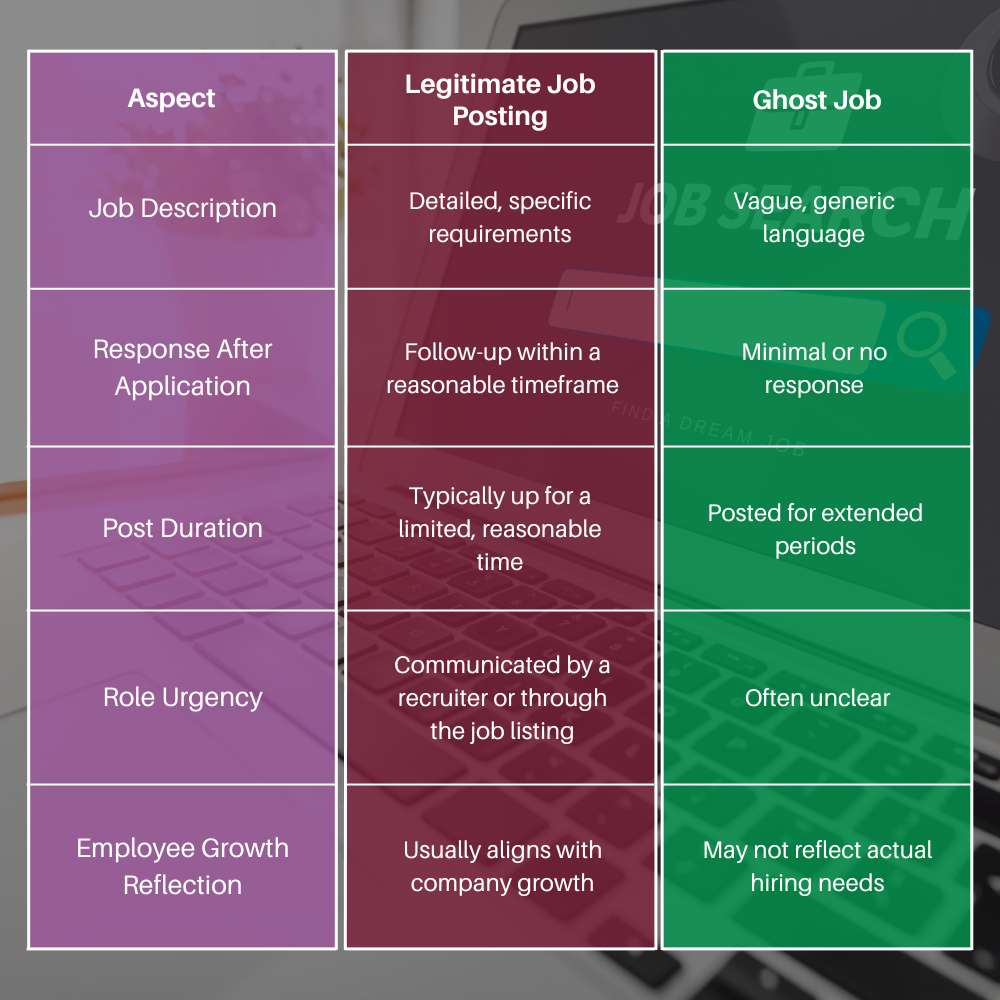Finding a job in the present market condition has been challenging, where competition is fierce and many job seekers are facing many hurdles. Ghost jobs are fake or misleading job postings that remain online despite not actively seeking to fill a position. Some employers may use these postings for brand visibility, data collection, or to showcase interest in certain roles, while others keep them up for appearances or administrative reasons. For job seekers, distinguishing between real and ghost jobs is essential to save time and energy. This guide explores how to spot ghost jobs, ensuring you focus your job search on genuine opportunities.
What Are Ghost Jobs?
Before learning how to spot ghost jobs, it’s crucial to understand what they are. Ghost jobs, also called phantom jobs, are positions posted by companies with no immediate intention of filling them. They often appear on company websites, job boards, and professional networks.
The reasons for these postings vary, but they typically include:
- Building a Talent Pool: Some companies post jobs to create a database of qualified candidates for future roles.
- Brand Awareness: Regular job listings can give an impression that a company is actively growing, enhancing its brand image.
- Testing Job Descriptions: Some employers post jobs to display interest in a role or test the effectiveness of a job description.
- Compliance or Policy: Certain companies are required to post job openings for compliance reasons, even if they don’t plan to hire.
While ghost jobs aren’t necessarily malicious, they can be frustrating for job seekers, leading to wasted time and false hopes.
Why It’s Important to Spot Ghost Jobs?

Understanding how to spot ghost jobs is beneficial for several reasons:
- Saves Time: Identifying fake listings early prevents you from investing time in applications that won’t be considered.
- Preserve Morale: Constant rejections or a lack of responses can be discouraging. Filtering out ghost jobs helps you focus on real opportunities, keeping you motivated.
- Enhances Strategy: By recognizing which listings are genuine, you can tailor your job search strategy to focus on legitimate openings, improving your chances of success.
Now, let’s discuss the steps on how to spot ghost jobs and avoid these frustrating postings.
Signs of a Ghost Job
While it’s not always easy to tell a ghost job from a genuine one, certain clues can help you identify them. Here’s how to spot ghost jobs by examining their common characteristics:
1. Vague or Recycled Job Descriptions
One of the primary signs of a ghost job is a job description that lacks specific details or seems generic. These postings often use unclear language that could apply to many roles, with little mention of specific skills or responsibilities. Additionally, if you come across the same job description across multiple sites or notice that a company reposts the same job repeatedly, this could be a sign that the listing is just for show.
2. Long-Term Openings with No Updates
A job that has been posted for months, or even years, without any changes is another sign of a ghost job. While some roles genuinely require extended time to fill, most companies update their listings regularly. When a job remains stagnant, it’s possible that the employer is using the posting to maintain brand visibility rather than actively hiring.
3. Lack of Communication After Application
If you apply to a job and receive no response, no updates, or automated replies only, this could indicate a ghost job. Legitimate job listings often involve follow-up emails, interview requests, or at least confirmation of your application. Repeated non-responses to applications for the same job might signal that the position was never intended to be filled.
4. Job Postings on Careers Pages with No Real Openings
Companies may post jobs on their career pages as placeholders. If you notice that a company’s job board always has a significant number of openings that never seem to change, it could mean these are ghost jobs. Large corporations may keep these postings to attract interest but aren’t actively recruiting for them.
5. Overly Broad Requirements
When the qualifications for a role seem too broad or non-specific, it’s worth considering whether it’s a ghost job. Real job postings generally include targeted requirements and qualifications, while ghost jobs may list generic or unrealistic qualifications that make it hard to determine the actual demands of the role.
6. Suspiciously High Turnover for the Same Position
If a specific role is posted repeatedly over a short period, this could indicate a high turnover rate, a position that’s difficult to fill, or a ghost job. Job seekers should approach such postings with caution, as they may reflect issues with the company or a lack of genuine intent to hire.
How to Spot Ghost Jobs on Popular Job Boards?
Learning how to spot ghost jobs on major job boards like LinkedIn, Indeed, and Glassdoor can be particularly helpful, as these platforms are popular among recruiters and job seekers. Here’s how to navigate them:
- LinkedIn: Check the company’s page to see if there’s a pattern of continuous job postings without any employee growth. Reviews from current or former employees can also provide insights into whether a company posts ghost jobs.
- Indeed: Use the Last Updated feature on job postings. If a job hasn’t been updated in several months, it’s likely not a priority.
- Glassdoor: Look at employee reviews for mentions of hiring practices. Some companies are known to post ghost jobs, and employees may mention this.
These tips help in how to spot ghost jobs on specific platforms and can prevent wasted time on applications for non-existent roles.
How to Avoid Applying to Ghost Jobs?

Now that you know how to spot ghost jobs, here are some practical steps to avoid applying to them:
- Research the Company’s Hiring Activity: Look into the company’s hiring history. If it frequently posts the same position, this might be a sign of a ghost job or high turnover.
- Set Up Alerts for New Postings: Setting alerts for new job postings can ensure that you only apply to recent listings, which are more likely to be real.
- Engage with the Company on Social Media: Follow the company on LinkedIn or Twitter. Sometimes, job openings are discussed on these platforms, and active recruiting efforts are often evident.
- Ask Questions: If you make it to an interview stage or have the opportunity to connect with a recruiter, ask about the urgency of the position. Honest recruiters will provide insight into the hiring timeline, which can reveal whether the role is real.
How to Handle Ghost Jobs After Applying?
Sometimes, despite all efforts, you may end up applying for a ghost job. Here’s how to proceed if you suspect you’ve applied to one:
- Follow Up Appropriately: Wait two to three weeks after applying, then send a polite follow-up email. If you get no response or receive vague feedback, it might confirm your suspicions.
- Document Your Applications: Keep a log of all your applications, including dates, follow-ups, and responses. If a job remains listed after multiple follow-ups with no response, it’s likely a ghost job.
- Evaluate the Company: Check online reviews and reach out to contacts in your network to get insights into the company’s hiring practices.
Why Do Companies Post Ghost Jobs?
Understanding the motivation behind ghost jobs can give you better insight into how and why these postings occur. Reasons include:
- Talent Pipelining: Companies build a pool of candidates for future openings, so they’re prepared when the role needs filling.
- Industry Benchmarks: Some companies post jobs to benchmark salaries or benefits against others in their industry.
- Image Management: Companies sometimes post jobs to appear as if they’re growing, fostering a positive perception among stakeholders and competitors.
While frustrating for job seekers, knowing these motivations can help you approach your job search more strategically.
Legitimate Job Postings vs. Ghost Jobs: Key Differences
Here’s how to spot ghost jobs by comparing them to legitimate postings:

| Aspect | Legitimate Job Posting | Ghost Job |
| Job Description | Detailed, specific requirements | Vague, generic language |
| Response After Application | Follow-up within a reasonable timeframe | Minimal or no response |
| Post Duration | Typically up for a limited, reasonable time | Posted for extended periods |
| Role Urgency | Communicated by a recruiter or through the job listing | Often unclear |
| Employee Growth Reflection | Usually aligns with company growth | May not reflect actual hiring needs |
This table can serve as a checklist for determining how to spot ghost jobs and avoid unnecessary applications.
Conclusion
Learning how to spot ghost jobs can save time, and energy, and help focus your job search on real opportunities. By understanding the signs—such as vague descriptions, extended postings, and lack of communication—job seekers can dodge these misleading listings and improve their chances of finding legitimate roles. Always remember to research companies, monitor job postings, and follow up professionally. Knowing how to spot ghost jobs ultimately helps keep your job search focused and productive, leading you to more accurate career opportunities.







